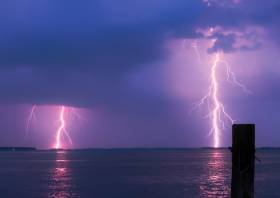Displaying items by tag: Lightning
‘Lucky Opportunistic Shot’ Catches Lightning Strike on Poolbeg Chimneys in Dublin Bay
Twitter user Roger McMorrow captured an incredible video of lightning striking the iconic chimneys of the Poolbeg power station during a thunderstorm over Dublin Bay on Tuesday (19 July).
The clinical director and consultant anaesthetist at the National Maternity Hospital got the shot of a lifetime from the vantage of St Vincent’s Hospital in the south of the city.
Explaining his technique, Roger said: “For all those asking this was taken with an iPhone 12 on Slowmo propped up on a window sill.”
Lightning strikes #ESB #Poolbeg towers as seen from St Vincents Hospital this afternoon. ⛈ ⚡️ #thunder #Lightning #Dublin pic.twitter.com/Kh1Exyff6K
— Roger McMorrow ???? (@RogerMcMorrow) July 19, 2022
He added with modesty: “Just a lucky opportunistic shot”
Roger’s clip quickly went viral on social media — as did another photo purporting to show the same phenomenon from a different angle. But browsers beware, as the breathtaking shot appears to have been altered for dramatic effect.
A shocking video shows the moment when a sailboat moored in a US harbour was struck by lightning.
The dramatic flash was caught on camera by a passer-by at the marina in South Boston as stormy weather rolled through the state of Massachusetts last Saturday 6 July.
While the boat took a serious hit — its sail bursting into flames as the bolt crackled through its mast — the owner was lucky enough not to be on board at the time, and CNN reports that no one was hurt in the incident.
Video captures the moment a bolt of lightning struck a sailboat in South Boston. The boat's owner was not on board, and there were no injuries. https://t.co/MDoUv0QKqx pic.twitter.com/UtXRrM5Qep
— CNN (@CNN) July 13, 2019





























































